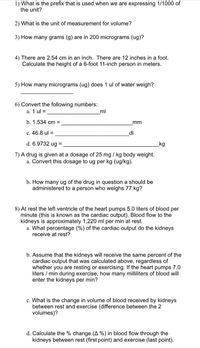
Biochemistry
9th Edition
ISBN: 9781319114671
Author: Lubert Stryer, Jeremy M. Berg, John L. Tymoczko, Gregory J. Gatto Jr.
Publisher: W. H. Freeman
expand_more
expand_more
format_list_bulleted
Concept explainers
Question

Transcribed Image Text:**Unit Conversion and Measurement Problems**
1. **Question**: What is the prefix that is used when we are expressing 1/1000 of the unit?
2. **Question**: What is the unit of measurement for volume?
3. **Question**: How many grams (g) are in 200 micrograms (µg)?
4. **Question**: There are 2.54 cm in an inch, and there are 12 inches in a foot. Calculate the height of a 6-foot 11-inch person in meters.
5. **Question**: How many micrograms (µg) does 1 µl of water weigh?
**Answer**:
6. **Convert the following numbers**:
a. 1 µl = ________________ ml
b. 1.534 cm = ________________ mm
c. 46.8 µl = ________________ dl
d. 6.9732 µg = ________________ kg
7. **Question**: A drug is given at a dosage of 25 mg/kg body weight.
a. Convert this dosage to µg per kg (µg/kg).
b. How many µg of the drug in question should be administered to a person who weighs 77 kg?
8. **Cardiac Output and Kidney Blood Flow**:
At rest, the left ventricle of the heart pumps 5.0 liters of blood per minute (this is known as the cardiac output). Blood flow to the kidneys is approximately 1,220 ml per minute at rest.
a. **Question**: What percentage (%) of the cardiac output do the kidneys receive at rest?
b. **Question**: Assume that the kidneys will receive the same percentage of the cardiac output that was calculated above, regardless of whether you are resting or exercising. If the heart pumps 7.0 liters per minute during exercise, how many milliliters of blood will enter the kidneys per minute?
c. **Question**: What is the change in the volume of blood received by the kidneys between rest and exercise (difference between the two volumes)?
d. **Question**: Calculate the percentage change (Δ %) in blood flow through the kidneys between rest (first point) and exercise (last point).
**Note**: Ensure that you understand the conversions between different units,
Expert Solution
This question has been solved!
Explore an expertly crafted, step-by-step solution for a thorough understanding of key concepts.
This is a popular solution
Trending nowThis is a popular solution!
Step by stepSolved in 2 steps

Knowledge Booster
Learn more about
Need a deep-dive on the concept behind this application? Look no further. Learn more about this topic, biochemistry and related others by exploring similar questions and additional content below.Similar questions
- Can two polydactylic people have a child without polydactyly? Please explain.arrow_forwardAs a genetic counselor, you inform Susan and John that a blood test for cystic fibrosis is available. Would you recommend genetic testing for Susan and John? Explain.arrow_forwardAnalyze the karyotype shown. Indicate if it is a chromosomal male or achromosomal female. If the karyotype is normal, write the word normal under name or description. If the karyotype is abnormal, name or describethe disorder.arrow_forward
- I am a little confused on this question.arrow_forwardHow many total chromosomes were on your karyotype sheets? How many of the chromosomes are autosomes? Is this child a male or a female? How do you know? Does this child appear to have a genetic disorder? If so, what genetic disorder does this child have?arrow_forwardwhat is the probability that a couple (both heterozygous for the same recessive mutation) will have two children with the disease if the couple plans to have four children in total?arrow_forward
- 1) What is the pure-breeding (or true-breeding) strain or organism?arrow_forwardd/1n5NtidRwTwUzcDkDPi5Z9P SHPZ9IA-XH-pfftLbhNc/edit 1) @ Is Add-ons Help Last edit was 15 minutes ago | Calibri в I UA 12 + 3I | II 6 1 I 7. Construct a Punnett square for a cross between two heterozygous pea plants with violet flower color. a. What genotypes would you expect in the offspring? b. What percentage or ratio of each genotype would you expect in the offspring? !!!arrow_forwardHow many total chromosomes were on your karyotype sheets? How many of the chromosomes are autosomes? Is this child a male or a female? How do you know? Does this child appear to have a genetic disorder? If so, what genetic disorder does this child have?arrow_forward
arrow_back_ios
SEE MORE QUESTIONS
arrow_forward_ios
Recommended textbooks for you
 BiochemistryBiochemistryISBN:9781319114671Author:Lubert Stryer, Jeremy M. Berg, John L. Tymoczko, Gregory J. Gatto Jr.Publisher:W. H. Freeman
BiochemistryBiochemistryISBN:9781319114671Author:Lubert Stryer, Jeremy M. Berg, John L. Tymoczko, Gregory J. Gatto Jr.Publisher:W. H. Freeman Lehninger Principles of BiochemistryBiochemistryISBN:9781464126116Author:David L. Nelson, Michael M. CoxPublisher:W. H. Freeman
Lehninger Principles of BiochemistryBiochemistryISBN:9781464126116Author:David L. Nelson, Michael M. CoxPublisher:W. H. Freeman Fundamentals of Biochemistry: Life at the Molecul...BiochemistryISBN:9781118918401Author:Donald Voet, Judith G. Voet, Charlotte W. PrattPublisher:WILEY
Fundamentals of Biochemistry: Life at the Molecul...BiochemistryISBN:9781118918401Author:Donald Voet, Judith G. Voet, Charlotte W. PrattPublisher:WILEY BiochemistryBiochemistryISBN:9781305961135Author:Mary K. Campbell, Shawn O. Farrell, Owen M. McDougalPublisher:Cengage Learning
BiochemistryBiochemistryISBN:9781305961135Author:Mary K. Campbell, Shawn O. Farrell, Owen M. McDougalPublisher:Cengage Learning BiochemistryBiochemistryISBN:9781305577206Author:Reginald H. Garrett, Charles M. GrishamPublisher:Cengage Learning
BiochemistryBiochemistryISBN:9781305577206Author:Reginald H. Garrett, Charles M. GrishamPublisher:Cengage Learning Fundamentals of General, Organic, and Biological ...BiochemistryISBN:9780134015187Author:John E. McMurry, David S. Ballantine, Carl A. Hoeger, Virginia E. PetersonPublisher:PEARSON
Fundamentals of General, Organic, and Biological ...BiochemistryISBN:9780134015187Author:John E. McMurry, David S. Ballantine, Carl A. Hoeger, Virginia E. PetersonPublisher:PEARSON

Biochemistry
Biochemistry
ISBN:9781319114671
Author:Lubert Stryer, Jeremy M. Berg, John L. Tymoczko, Gregory J. Gatto Jr.
Publisher:W. H. Freeman

Lehninger Principles of Biochemistry
Biochemistry
ISBN:9781464126116
Author:David L. Nelson, Michael M. Cox
Publisher:W. H. Freeman

Fundamentals of Biochemistry: Life at the Molecul...
Biochemistry
ISBN:9781118918401
Author:Donald Voet, Judith G. Voet, Charlotte W. Pratt
Publisher:WILEY

Biochemistry
Biochemistry
ISBN:9781305961135
Author:Mary K. Campbell, Shawn O. Farrell, Owen M. McDougal
Publisher:Cengage Learning

Biochemistry
Biochemistry
ISBN:9781305577206
Author:Reginald H. Garrett, Charles M. Grisham
Publisher:Cengage Learning

Fundamentals of General, Organic, and Biological ...
Biochemistry
ISBN:9780134015187
Author:John E. McMurry, David S. Ballantine, Carl A. Hoeger, Virginia E. Peterson
Publisher:PEARSON